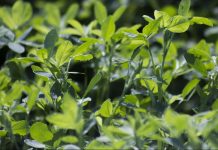Grazing cows produce milk with more favorable characteristics from a human health perspective than do cows on silage or high concentrate diets. That is the message that Dr. Anjo Elgersma shared with a group of dairy producers from the Ohio Forage and Grasslands Council and in Wisconsin in late October last year.
Dr. Anjo Elgersma is an Associate Professor in Grassland Science at Wageningen University in The Netherlands. She has been studying feeding management effects on milk composition.
More Anti-Cancer CLA with Grazing
Cows grazing fresh grass outdoors produced milk with more polyunsaturated fatty acids and less saturated fatty acids than did cows on silage-based diets in studies conducted by Dr. Elgersma.
Cows on fresh pasture produce milk with much higher contents of conjugated linoleic acids (CLA). The type of CLA found in milk has been shown to have anti-cancer effects in animal studies.
This is significant because the fatty acid composition of milk in many countries has become less favorable in the last few decades. Dr. Elgersma believes this is the result of cows being fed high concentrate and silage diets.
Pasture vs Indoor Feeding
Elgersma’s initial studies focused on how rapidly fatty acid composition of milk was altered as cows were moved from 24-hour grazing to only daytime grazing, to 24-hour indoor feeding. The milk produced on pasture had the highest levels of CLA followed by milk from cows grazing only during day time.
The lowest levels of CLA were found in milk from cows kept indoors 24-7. When cows were moved from pasture to indoor silage feeding, the reduction in CLA composition occurred within 2 days. There is a clear and rapid relationship between what the cow ingests and what is in the milk.
Bacteria in the cow’s rumen convert the fatty acid precursors found in forage into beneficial milk fatty acids. Ensiling forages changes the fatty acid precursors found in fresh material and cows fed silage have lower CLA content in their milk.
USA Studies
Studies conducted by scientists at the US Dairy Forage Research Center of the USDA have shown that cows grazing permanent natural pasture had five times more CLA compared with cows fed a total mixed ration of stored forages and grain. Feeding dry grass hay made from the same pasture did not increase milk CLA content compared with cows on the total mixed ration.
Another study conducted by scientists at Cornell and Penn State Universities indicated that CLA in milk fat is enhanced by dietary intake of fresh pasture. Once cows were fully adjusted to an all pasture diet, the CLA content was doubled in the milk compared with the control group on a total mixed ration. However, the group on pasture produced 19% less milk than the control group on the ration.
Fresh Young Grass Is Best. Dr. Elgersma conducted another study comparing the milk from cows that grazed standing fresh grass versus cows that were fed in an adjacent paddock where the grass was cut and left in a pile (greenchop). The two groups of cows were in side-by-side paddocks that had just enough forage for a single day.
The cows grazing the standing forage produced more CLA in their milk than cows feeding the cut grass. All cows were essentially eating from the same pasture in the field, except one group was grazing standing forage and the other a one-days allotment of cut forage. Presumably, the grazing cows were able to select a better diet from the standing forage than when the grass was mechanically cut for them.
Plant Factors Affecting Fatty Acids
Fatty acid content is higher in leaf blades than stems. Fatty acids decline in forage with advancing maturity. So providing leafy, young forage to a grazing cow will increase intake of the beneficial precursors of CLAs.
Forage species may also differ in fatty acid profiles. In one study, chicory contained the highest level of total fatty acids and was superior in nutritional composition to the other species evaluated. Dr. Elgersma found that some herb species had interesting fatty acid profiles and timothy had the lower levels of crude protein and fatty acids than the herbs, but timothy was not compared with other grasses.
More work is needed to define how forage species affects CLA composition in milk.
What Difference Does This Make?
So milk from cows grazing fresh, young forage has much higher unsaturated fatty acid content than milk produced from high silage and concentrate diets. Does this make a difference for dairy producers? It is making a difference in The Netherlands. Farmers of Dutch cooperatives who produce milk from grazed grass now receive a premium payment over the base milk price. With more evaluation, perhaps the same will be true here.
Consumer Perspective
There is increasing interest in food quality and safety. There are opportunities for differentiated products in the marketplace. Grazing results in a higher quality milk product. These positive characteristics remain the same when the milk is processed into yogurt and cheeses. Some of you reading this article can think of ways to put that information to good use.
Grazing for Higher Milk
CLA Based on what Dr. Elgersma shared with us during her visit to the U.S., there are specific management strategies that can be developed to increase the level of beneficial CLAs in milk.
First, have the cows directly graze as much of their diet as possible. Secondly, provide young and leafy forage to the grazing herd. Third, make enough forage available so that they can selectively graze the leafy high-quality forage. This will improve the CLA content of the milk. You might consider a leader-follower strategy, with your best cows grazing the high quality forage first. Then follow with lower producing cows and dry cows to clean up the leftovers. This implies good rotational grazing management.
For More Information
I hope you have found this information as interesting as I have. If you would like more details, you might want to consider a book co-authored by Dr. Elgersma entitled “Fresh Herbage for Dairy Cattle: The Key to a Sustainable Food Chain”. While I have not yet read that book, I was impressed with the research information Dr. Elgersma shared with us during her visit here.
An internet search will turn up several sources of the book, including a paperback version. You can find several other information sources online with a search of “conjugated linoleic acids in milk.” Be careful as you read materials on this subject, that they are published in a respected journal.
(The author is a professor in the Department of Horticulture and Crop Science at Ohio State University. Questions and comments can be sent in care of Farm and Dairy, P.O. Box 38, Salem, OH 44460.)












